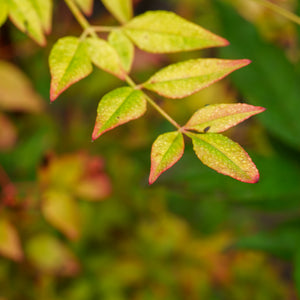The Nandina Guide
Nandina (Nandina domestica), often called heavenly bamboo, is a tough and colorful evergreen shrub known for its finely textured foliage, dramatic seasonal color changes, and vibrant red berries. Despite its common name, it is not a true bamboo but shares a similar upright, cane-like structure. Native to eastern Asia and widely cultivated across the U.S., Nandina offers year-round interest in gardens with minimal maintenance.
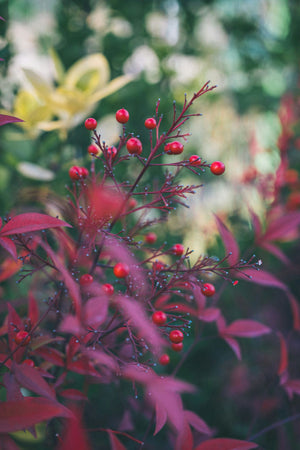
About
Nandina is a multi-stemmed, upright evergreen or semi-evergreen shrub that typically grows 2 to 8 feet tall depending on the cultivar. Its lacy, pinnate foliage emerges with shades of red and bronze in spring, matures to green in summer, and turns fiery red or burgundy in fall and winter. In summer, it produces small white flowers that give way to clusters of red berries in fall and winter—an important ornamental feature.
There are many popular cultivars tailored to different landscape needs:
- ‘Gulf Stream’ – Compact and dense, typically 3 feet tall with excellent foliage color.
- ‘Fire Power’ – Dwarf form with vivid red fall and winter foliage; ideal for mass plantings.
- ‘Harbor Dwarf’ – Low-growing variety for edging and groundcover.
- ‘Goldstream’ – Known for its golden-yellow foliage that deepens to copper in fall.
Nandina is widely used in foundation plantings, borders, and low-maintenance gardens. Its ability to thrive in sun or shade, resist browsing deer, and tolerate drought once established makes it highly versatile. However, in some southern states, it has been flagged as invasive due to prolific reseeding and spread in natural areas.
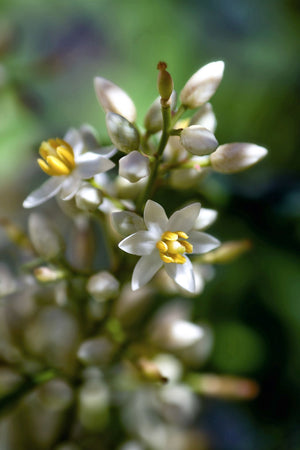
PLANTING
Nandina is adaptable to a wide range of growing conditions but performs best with thoughtful placement.
USDA Hardiness Zones: Most cultivars thrive in Zones 6–10, with some cold-hardy forms surviving in Zone 5.
Soil: Prefers well-drained soil with average fertility. It tolerates clay and sandy soils but struggles in overly wet or poorly drained locations.
Sunlight: Grows well in full sun to part shade. Full sun produces the most intense foliage color, especially in fall and winter. Too much shade can cause legginess and dull color.
Watering: Moderate water needs. Water regularly during establishment. Mature plants are drought-tolerant but benefit from occasional deep watering during hot or dry spells.
Spacing: Space 2 to 5 feet apart depending on the cultivar’s mature size. Allow room for airflow between plants to reduce the risk of fungal issues.
Planting Time: Plant in early spring or fall when temperatures are mild and rainfall is more consistent.
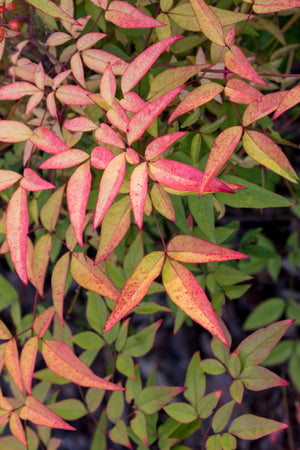
CARE
Watering: Keep the soil consistently moist during the first growing season. Once established, water during prolonged dry periods, especially in hot climates.
Fertilizing: Apply a balanced, slow-release fertilizer in early spring to support foliage color and healthy growth. Avoid over-fertilizing, which can encourage spindly growth.
Pruning: Prune in late winter to early spring to maintain size, shape, and density. Thin older canes by cutting them to the ground to encourage fresh growth. Remove flower heads if you want to limit berry production, especially in areas where it may spread aggressively.
Pests and Diseases: Generally pest-free and disease-resistant. Overly wet or compacted soils may lead to root rot. Occasional aphids or scale may appear but are rarely serious.
Mulching: Apply a 2-3 inch layer of mulch around the base to conserve moisture and moderate soil temperature. Keep mulch several inches away from stems.
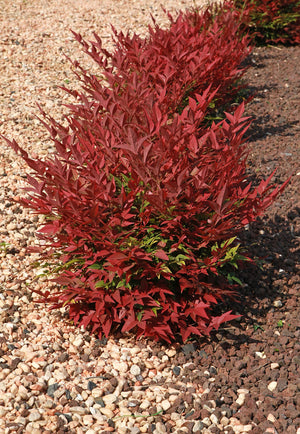
HOW TO USE
Focal Point: Vibrant foliage and winter berries make Nandina an attractive focal point in small garden beds or container plantings. Cultivars like ‘Fire Power’ and ‘Gulf Stream’ stand out with intense seasonal color.
Foundation Plantings: Use compact cultivars like ‘Gulf Stream’ or ‘Harbor Dwarf’ in front of buildings or patios where year-round foliage adds structure without overwhelming the space.
Mass Plantings and Borders: Plant in groups for a bold, uniform look. The changing colors and upright form create visual interest across seasons.
Woodland Edges: Nandina blends well in transitional spaces between manicured gardens and naturalistic plantings. Its form and texture pair well with ferns, hellebores, or carex.
Containers: Dwarf varieties perform well in containers for patios, balconies, or entryways. Choose well-drained potting mix and water regularly.
Winter Gardens: The persistent berries and bold foliage add life and contrast to otherwise bare winter landscapes. Pair with evergreens like boxwood or camellia.
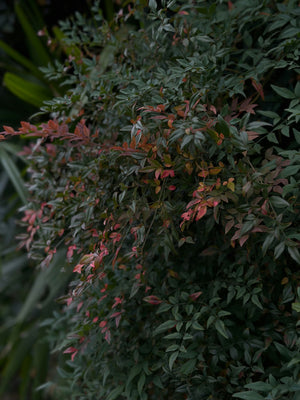
Common Questions
Are nandina berries poisonous? Yes. Nandina berries contain cyanogenic glycosides, which can be toxic to birds and pets if ingested in large quantities.
When and how to prune nandina? Prune in late winter to remove older canes at the base and shape the plant. Avoid shearing, which leads to legginess. Pruning encourages denser, more colorful new growth.
Is nandina invasive? In parts of the southeastern U.S., Nandina has become invasive due to prolific berry production and spread. Use sterile or non-fruiting cultivars in sensitive regions.
Do deer or rabbits eat nandina? Nandina is generally deer- and rabbit-resistant due to its bitter foliage.
Is nandina toxic to pets? Yes. The berries are toxic to cats and dogs and may cause vomiting, lethargy, or worse if consumed in large amounts.
Does nandina need full sun? It performs best in full sun, which enhances leaf color, but tolerates partial shade. Too much shade may reduce coloration and encourage sparse growth.
How big does nandina grow? Size depends on the cultivar. Dwarf types may stay under 2 feet tall, while larger forms can reach 6 to 8 feet with age.
Conclusion
Nandina is a reliable, low-maintenance shrub that brings year-round beauty through ever-changing foliage and vibrant berries. Ideal for borders, foundations, and container gardens, it adapts well to sun or shade and resists deer and drought. With thoughtful placement and occasional pruning, Nandina remains a valuable and ornamental plant for modern landscapes—especially where vibrant color and tidy form are desired.
The Nandina Collection
Sold Out
Sold Out
Sold Out
Sold Out
Sold Out

